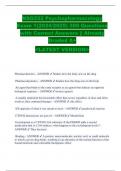NSG552 Psychopharmacology
Exam 1(2024/2025) 300 Questions
with Correct Answers || Already
Graded A+
<LATEST VERSION>
Pharmacokinetics - ANSWER ✔ Studies how the body acts on the drug
Pharmacodynamics - ANSWER ✔ Studies how the drug acts on the body
An agent that binds to the same receptor as an agonist but induces an opposite
biological response: - ANSWER ✔ inverse agonist
A usually undesired but forseeable effect that occurs regardless of dose and often
resolves after continued therapy: - ANSWER ✔ side effect
S/S opposite of what it was meant to treat: - ANSWER ✔ paradoxical reaction
CYP450 interactions are part of: - ANSWER ✔ Metabolism
Escitalopram is a CYP450-3A4 substrate. If the PMHNP adds a second
medication that is a 3A4 inducer, what happens to the escitalopram levels? -
ANSWER ✔ They decrease
Binding - ANSWER ✔ A protein, macromolecule, nucleic acid, or small molecule
to which a given drug binds, resulting in an alteration of the normal function of the
bound molecule and a desirable therapeutic effect.
, Affinity - ANSWER ✔ the extent or fraction to which a drug binds to receptors at
any given drug concentration
CYP450 - ANSWER ✔ Cytochrome P450 (CYP450), a large superfamily of
heme-thiolate proteins, are involved in the metabolism of both exogenous and
endogenous compounds
Symptoms of schizophrenia are divided into these two categories: - ANSWER ✔
Positive and negative
T/F Antipsychotic polypharmacy can increase the risk of re-hospitalization,
diabetes, EPS, sedation, seizures, metabolic effects, mortality, and sudden cardiac
death. - ANSWER ✔ T
Alogia, anhedonia, avolition and cognitive symptoms: - ANSWER ✔ Negative
symptoms
Delusions, hallucinations, hostility, grandiosity: - ANSWER ✔ Positive
Symptoms
Another name for 1st generation antipsychotics: - ANSWER ✔ Typical
antipsychotics, FGA
Another name for 2nd generation antipsychotics: - ANSWER ✔ Atypical
antipsychotics, SGA
First line treatment for Schizophrenia: - ANSWER ✔ Second-generation
antipsychotics (except clozapine)
This class is associated with fewer neurological side effects and effective for both
positive and negative symptoms: - ANSWER ✔ Second-generation antipsychotics
This class is effective for only positive symptoms and can in fact worsen negative
symptoms due to decreased DA in the mesocortical pathway: - ANSWER ✔ First
generation antipsychotics
, Associated with metabolic side effects: - ANSWER ✔ Second-generation
antipsychotics
What are the metabolic side effects associated Atypical antipsychotics: -
ANSWER ✔ Hyperglycemia, glucose disregulation, lipid disturbance. Leading to
HTN/DMII/metabolic d/o
Includes medications such as Haloperidol, chlorpromazine, fluphenazine,
perphenzine: - ANSWER ✔ FGA
Medications for acute agitation or psychosis: - ANSWER ✔
Includes medications such as Olanzapine, Quetiapine, Risperidone, Clozapine, etc:
- ANSWER ✔ SGA
FGA reduce dopamine transmission by blocking ___________ receptors: -
ANSWER ✔ D2
SGA block both _____________ and _________________ receptors: - ANSWER
✔ D2 and Serotonin (usually with 5-HT2A)
High incidence of QTC prolongation, Tardive dyskinesia, Neuroleptic Malignant
Syndrome (NMS), orthostatic hypotension: - ANSWER ✔ Typical
H1 blockade leads to symptoms of ____________ and ____________: -
ANSWER ✔ sedation and weight gain
Involuntary teeth grinding associated with antipsychotics: - ANSWER ✔ Bruxism
Safest and best tolerated anticonvulsant for patients taking clozapine who
experience dose-related seizures: - ANSWER ✔ valproate
Less incidence of antiadrenegic, anticholinergic and antihistamine side effects but
greater EPS: - ANSWER ✔ Higher potency antipsychotics
Greater incidence of antiadrenergic anticholinergic and antihistamine side effects
but less EPS: - ANSWER ✔ Lower potency antipsycotics
, Characterized by bradykinesia, mask-like face, cogwheel rigidity, pill rolling,
tremor: - ANSWER ✔ Parkinsonian side effects
Characterized by torticollis, oculogyric crisis, and can be life threatening if it
affects the airway: - ANSWER ✔ Acute dystonia
Characterized by an internal and external restlessness, constant need to pace or
walk: - ANSWER ✔ akithesia
Onset of symptoms for dystonia: - ANSWER ✔ hours to days after starting
treatment
Onset of symptoms for Parkinsonism/Akathisia: - ANSWER ✔ days to weeks
after starting antipsychotic treament
Onset of symptoms of Tardive Dyskinesia: - ANSWER ✔ late onset. Usually
months to years after initiating antipsychotic treatment.
T/F Medications for EPS such as Cogentin, Benadryl, and benzos should not be
co-prescribed to prevent EPS. Why or why not? - ANSWER ✔ True - the
medicaitons shouldn't be prescribed prophylacticalyl as there is then an increased
risk for anticholinergic side effects
First-line treatment for dystonia - ANSWER ✔ Cogentin
First line treatment for akathisia - ANSWER ✔ Propranolol
Occurs due to D2 blockade in the nigrostriatal pathway and is mostly irreversible:
- ANSWER ✔ Tardive dyskinesia
Characteristics of Tardive Dyskinesia: - ANSWER ✔ blinking eyes rapidly,
smacking lips, puffing out cheeks, grunting, frowning/grimacing, chewing motions
sticking tongue out or poking it into inside of the cheek etc
Atypical antipsychotic less likely to cause Tardive Dyskinesia: - ANSWER ✔
Clozaril. Can be used to treat tardive dyskinesia.




